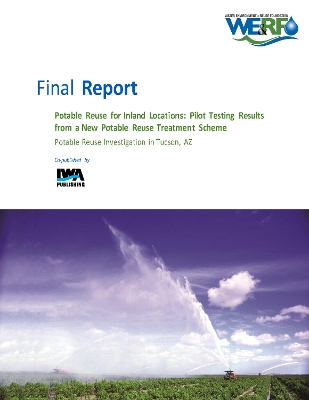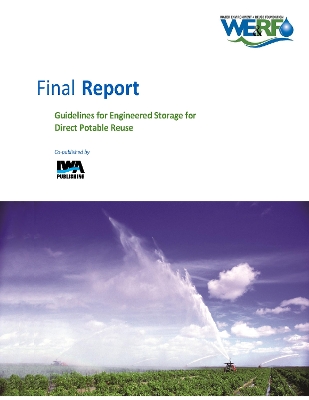WERF Research Report
2 total works
Reuse-13-09
A dual-membrane treatment approach for potable reuse that includes microfiltration (MF), reverse osmosis (RO), and ultraviolet advanced oxidation (UVAOP) has been used at a number of full-scale facilities. Most of these facilities are located in coastal areas where the RO concentrate can be discharged with relative ease through existing ocean outfalls. Implementation of RO-based projects at inland locations can be challenging because of the environmental difficulty and high cost of disposing the waste stream generated by the RO process. The purpose of this research project was to evaluate, on a pilot scale, the feasibility of an alternative potable reuse treatment scheme that produces highly purified water without the need for RO and, therefore, in a more sustainable manner.
The treatment process evaluated in this research used a combination of processes, including short-term soil aquifer treatment (SAT), side-stream nanofiltration (NF), ozone oxidation, biological activated carbon (BAC) filtration, and granular activated carbon (GAC) adsorption. These processes provide multiple pathogen and organic barriers and achieve a significant degree of salinity reduction while producing less concentrate with significantly lower salinity than RO-based plants, creating more options for concentrate disposal. A simplified process flow diagram for the pilot-scale, potable reuse treatment scheme is shown in Figure ES.1. The process arrangement was designed to achieve the projects' potable reuse treatment requirements (provide multiple barriers for removal of pathogens and organics and partial removal of total dissolved solids (TDS)) while minimizing project capital and operating costs. Successful demonstration of this alternative potable reuse scheme has the potential for application at a variety of inland locations that lack the less costly concentrate disposal method of ocean discharge.
A common treatment approach implemented at multiple potable reuse facilities around the world is microfiltration, reverse osmosis (RO) and advanced oxidation. Most of these facilities are located in coastal areas where the RO concentrate is discharged to the ocean. Implementing RO-based projects at inland locations is challenging because this is not an option. The purpose of this project was to evaluate the feasibility of an alternative non-RO-based potable reuse treatment scheme that produces highly purified water.
The treatment process evaluated in this research used a combination of processes, including short-term soil aquifer treatment (SAT), side-stream nanofiltration (NF), ozone oxidation, biological activated carbon (BAC) filtration, and granular activated carbon (GAC) adsorption. These processes provide multiple pathogen and organic barriers and achieve a significant degree of salinity reduction while producing less concentrate with significantly lower salinity than RO-based plants, creating more options for concentrate disposal. A simplified process flow diagram for the pilot-scale, potable reuse treatment scheme is shown in Figure ES.1. The process arrangement was designed to achieve the projects' potable reuse treatment requirements (provide multiple barriers for removal of pathogens and organics and partial removal of total dissolved solids (TDS)) while minimizing project capital and operating costs. Successful demonstration of this alternative potable reuse scheme has the potential for application at a variety of inland locations that lack the less costly concentrate disposal method of ocean discharge.
A common treatment approach implemented at multiple potable reuse facilities around the world is microfiltration, reverse osmosis (RO) and advanced oxidation. Most of these facilities are located in coastal areas where the RO concentrate is discharged to the ocean. Implementing RO-based projects at inland locations is challenging because this is not an option. The purpose of this project was to evaluate the feasibility of an alternative non-RO-based potable reuse treatment scheme that produces highly purified water.
Reuse-12-06
Guidelines for Engineered Storage for Direct Potable Reuse
by Andrew Salveson, Shane Snyder, and Linda MacPherson
Published 15 September 2016
Direct potable reuse (DPR) is the planned introduction of recycled water either directly into a public water system or into a raw water supply immediately upstream of a water treatment plant. DPR has inherent risks that differ from treatment of traditional source waters and conventional indirect potable reuse (IPR). In particular, DPR is a more closely coupled system, in which there is less time to monitor process water quality and respond to water quality concerns. This study evaluates how to replace the environmental buffer with engineered storage, called the engineered storage buffer (ESB). The ESB is a storage basin that provides sufficient time to monitor and respond to water quality concerns, called the failure response time (FRT). The ESB can also be designed to provide a measure of redundant treatment at a relatively low cost. It is envisioned as a tool to monitor process performance as it pertains to acute contaminants, with the primary focus on pathogen removal. The ESB is not envisioned as a long-term monitoring approach that could allow for FRT for chronic contaminants that have long analytical turnaround times.
This report details how to determine the size of ESB through the use of advanced monitoring technologies and an evaluation of the treatment benefits of a range of processes. It also examines the public's perception of IPR, DPR, and the environmental buffer, using a novel animation and a targeted web-based survey.
This report details how to determine the size of ESB through the use of advanced monitoring technologies and an evaluation of the treatment benefits of a range of processes. It also examines the public's perception of IPR, DPR, and the environmental buffer, using a novel animation and a targeted web-based survey.

